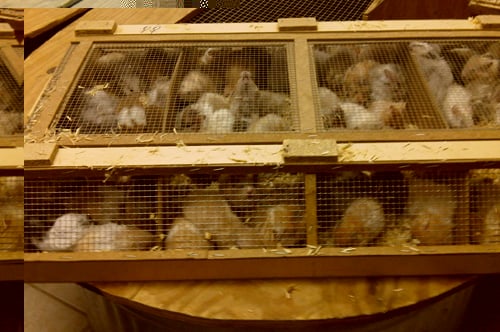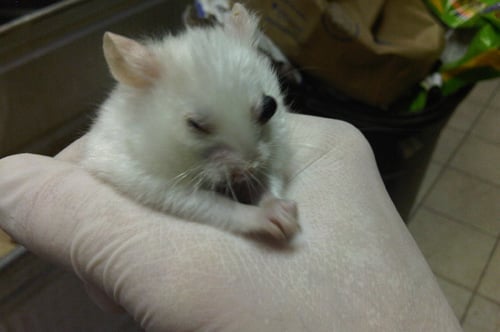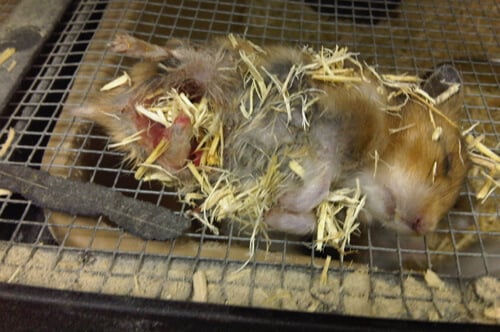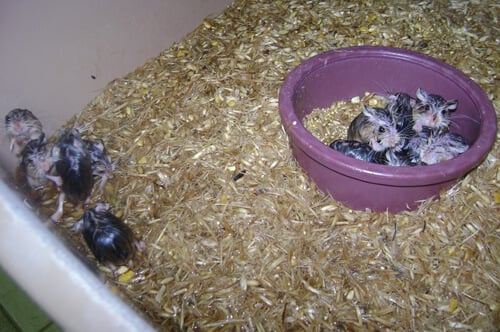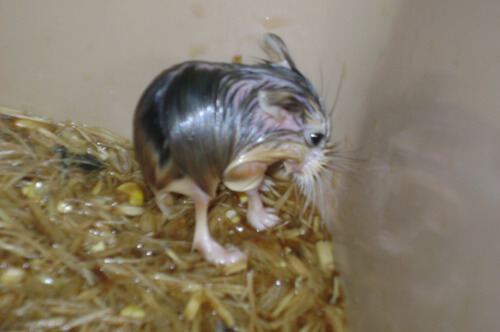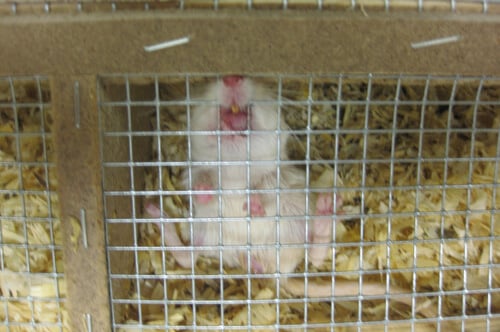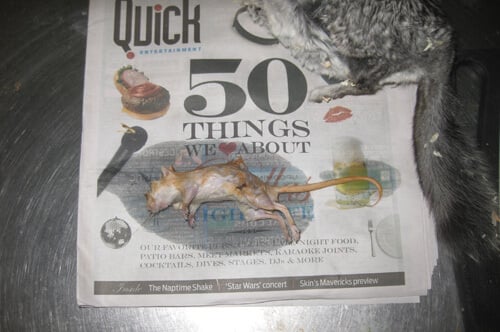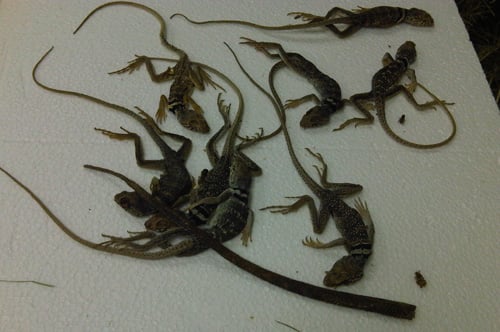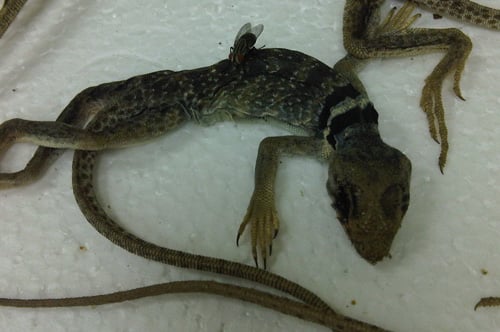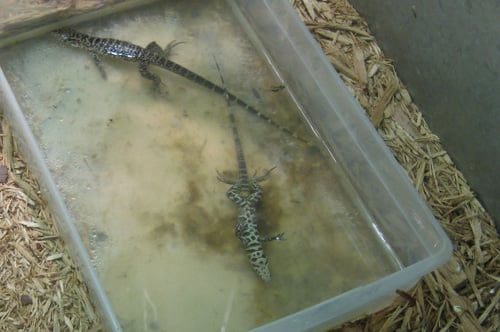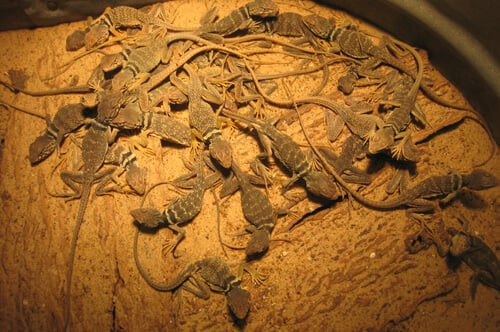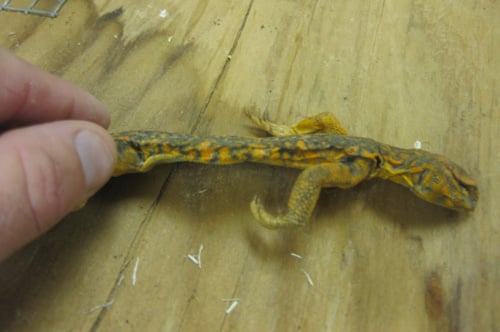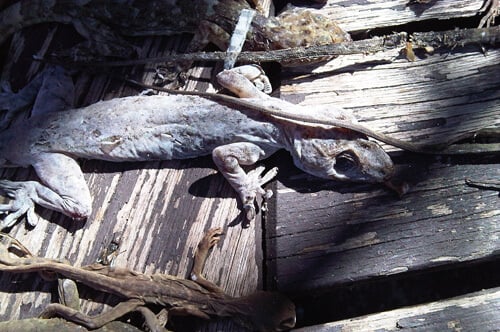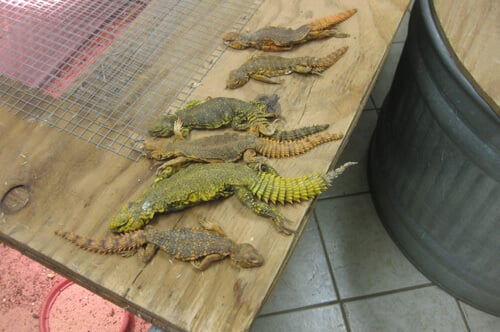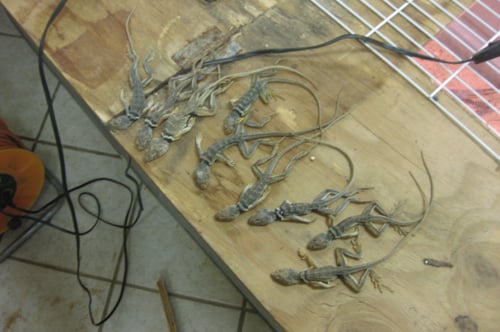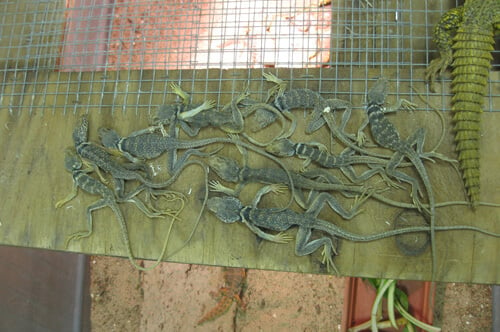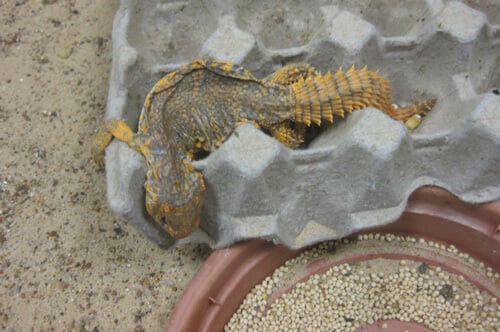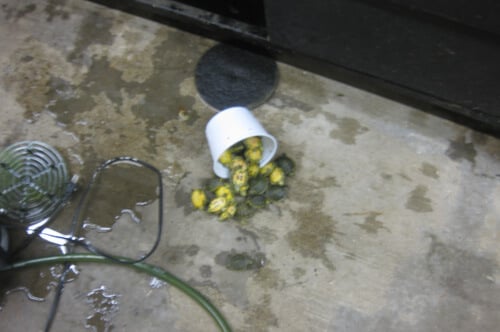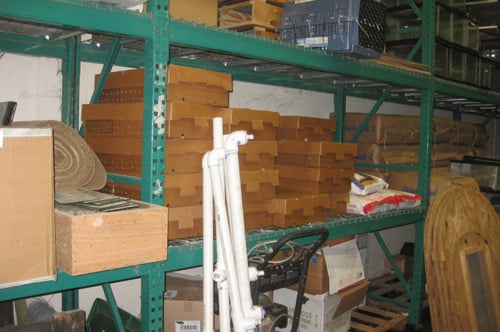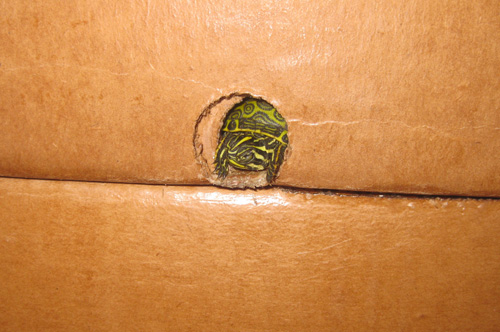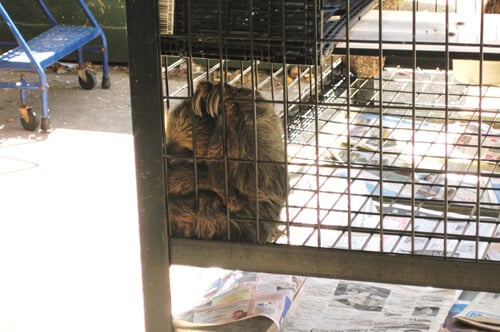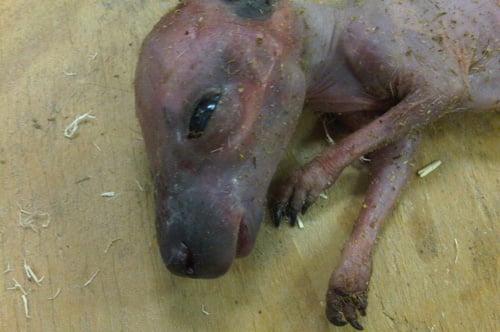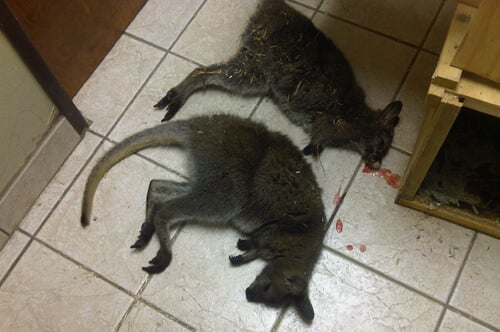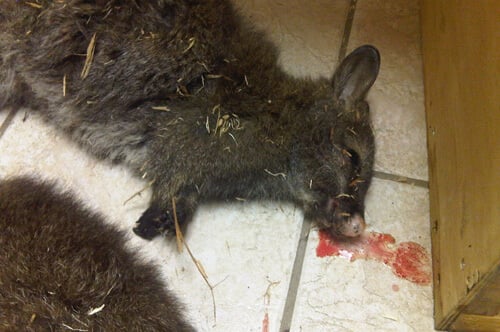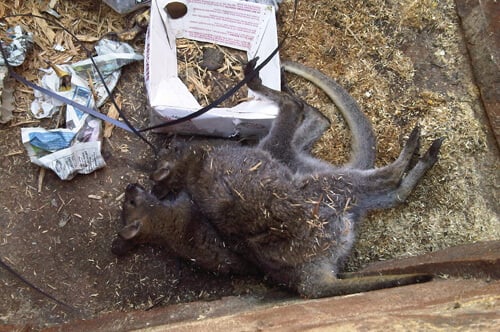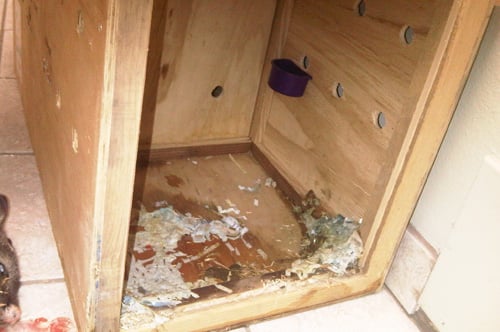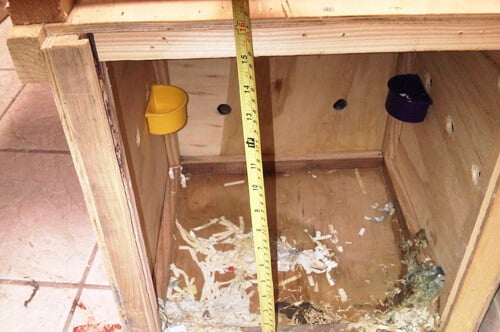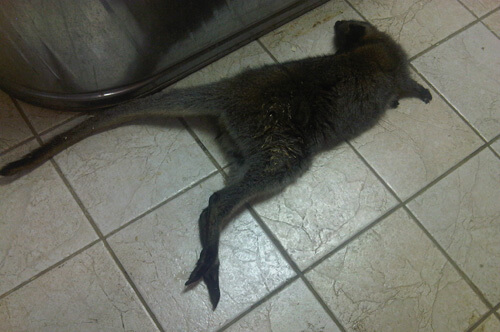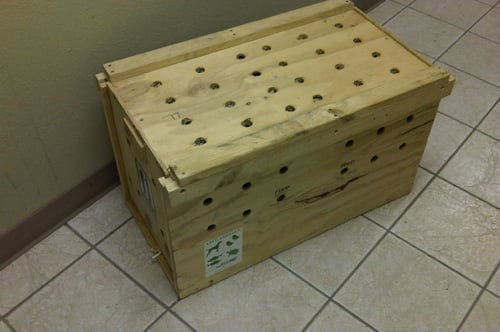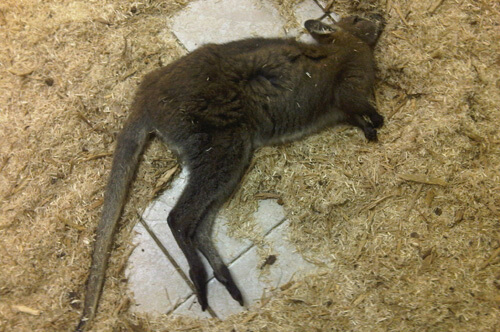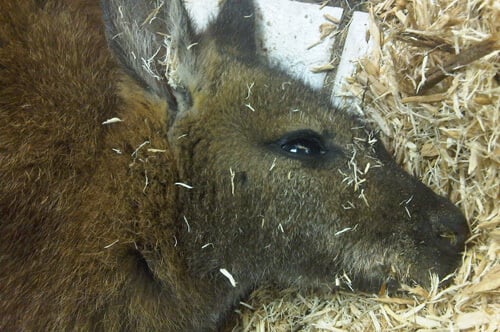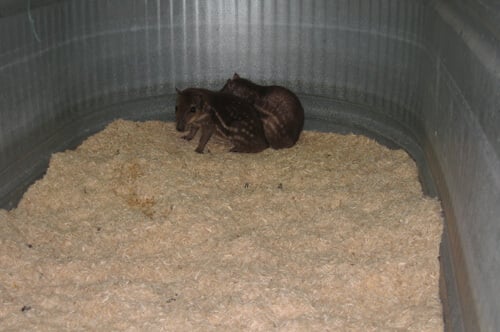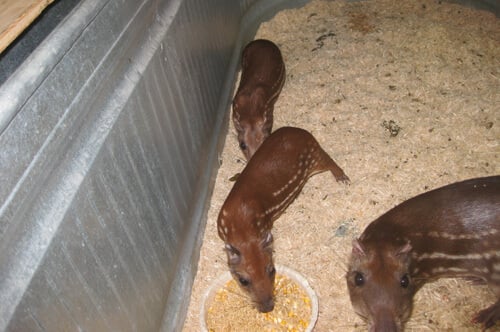Behind the Scenes in the Pet Trade
For seven months, a PETA investigator went undercover at U.S. Global Exotics (USGE), a massive international exotic-animal wholesale facility in Arlington, Texas. At the time, USGE was one of the nation’s largest sellers of exotic animals to distributors and pet stores around the world. In the U.S., USGE shipped mammals, reptiles, amphibians, arachnids, and other animals to pet stores, breeders, and other wholesale distributors, including suppliers to PETCO and PetSmart. One such supplier was Rainbow World Exotics, at which similarly horrific conditions were found by another undercover PETA investigator. PETA’s investigation of USGE and courtroom testimony also revealed that the company directly supplied animals to national chain Petland.
USGE confined tens of thousands of animals to its facility and employed a staff of three or four people to care for them. PETA’s investigation revealed that hamsters, gerbils, hedgehogs, chinchillas, ferrets, snakes, lizards, turtles, tortoises, frogs, wallabies, sloths, anteaters, kinkajous, and other exotic animals suffered terribly as a result of continuous, cruel confinement to severely crowded and filthy enclosures. Animals at USGE were denied not only a natural habitat but also the most basic necessities, including food, water, adequate air and space, humidity, heat, veterinary care, and even a painless end to their misery.
Primates and other sophisticated mammals at USGE were locked inside barren bins and cages as well as dark, dungeon-like metal troughs, sometimes for months. Animals who were subjected to this type of cruel confinement were driven to desperate behaviors such as incessant pacing, “back flips,” and other repetitive movements; frantic clawing at cage openings in an attempt to escape; fighting for space and food; and refusing to eat. Hundreds of injured and dying squirrels, lizards, and snakes were frozen to death in USGE’s chest freezer, in which some animals remained alive for hours before finally dying.
Snakes
Snakes perished daily at the facility. Many were wild-caught and shipped to the facility from all over the world to be stored in shoebox-size containers or extremely crowded troughs. They were starved and deprived of a proper heat source, adequate space, and even water, and many languished, suffered seizures, and died over the course of weeks and months. Hundreds of snakes were put into a freezer to die, slowly and painfully. Snakes routinely got loose—a threat to their own as well as other animals’ safety. Many others died as a result of untreated illnesses, infections, and/or injuries.
In order to save money, the company’s owners often refused to order the food needed to sustain life for many of the snakes. The company vice president deemed a veterinarian’s recommended course of treatment for hundreds of sick snakes “f***ing ludicrous” and “ridiculous” because of the effort and expense it would have required, which were minimal. On the day of the seizure, reptile experts found hundreds of suffering snakes deprived of the basics that they needed to survive, including heat, humidity, adequate space, UV lighting, and more.
Frogs and Toads
Tiny frogs were packed inside 2-liter plastic soda bottles piled into a cardboard box. Denied food, water, heat, humidity, and air, the frogs remained inside the bottles sometimes for weeks, until they were sold or they died—whichever came first. When it was time for shipping, the bottles were violently shaken, and the fragile frogs were yanked out by their legs and stuffed into “shipping cups.” Larger frogs and toads went hungry inside metal troughs, imprisoned amid their own waste and the rotting remains of other frogs.
On the day of the seizure, PETA’s team of experts found land frogs confined to the same dry troughs as aquatic frogs; emaciated, dehydrated, discolored, dying and dead frogs and toads; toads with prolapsed rectums; and toads whose faces were rubbed raw and bloody as a result of their repeated attempts to escape the crowded enclosures that they were being kept in. One of PETA’s experts opined, “Many frogs requiring high humidity levels, such as tree frogs, were housed in cages with one potted plant and newspaper on the cage bottom. … [T]he conditions were so insufficient that many of the plants were wilting and dying. Frogs found in these cages were commonly all crowded in the potting soil as this is the only location where they had access to hiding places under dead [leaves].”
'Pocket Pets'
Hedgehogs, ferrets, sugar gliders, chinchillas, various squirrels, and prairie dogs—commonly referred to as “pocket pets”—were fatally neglected by USGE. One young hedgehog, mauled by another and found with his front leg barely attached (just by the skin), was denied care or even euthanasia by the facility. Injured and/or sick animals—including a spotted squirrel whose neck was so badly wounded that muscle was exposed and a chinchilla with a prolapsed rectum—were intentionally put in a freezer to die.
On the day of the seizure, authorities found more than 60 dead sugar gliders bagged in one of the facility’s chest freezers as well as hundreds of hedgehogs crammed by the dozen into metal troughs, including starving and dying newborns whose mothers were too stressed to nurse them and who were being crushed to death by adult hedgehogs fighting for space, food, water, and places to hide.
Hamsters and Gerbils
Thousands of hamsters—whose ultimate destinations were major pet store chains around the nation, including PETCO and PetSmart location—were cruelly confined to dark, barren, extremely crowded litter pans, which resulted in severe psychological distress, terrible fighting, cannibalization, wounds, infections, and daily deaths. Faulty watering-system nozzles routinely flooded bins and often left hamsters and gerbils to fight for hours to keep their heads above water or drown.
On the day of the seizure, authorities found hundreds of frantic hamsters crammed—without access to food or water—into shipping crates that had arrived from the Netherlands the previous day and were left unpacked. USGE was known to receive such massive shipments from the Netherlands at least once a week.
Lizards
Lizards and salamanders died by the thousands en route to USGE as well as at the facility itself. Extreme crowding, starvation, dehydration, and untreated disease left iguanas, tegus, anoles, geckos, salamanders, and other lizards to waste away for days and weeks. Many were never unpacked upon arrival at USGE; they perished inside mesh bags and “shipping cups,” then were photographed and claimed as “deads” so that the facility owner could ask his suppliers for refunds.
On the day of the seizure, the decomposing, liquefying remains of more than 200 iguanas were extracted from bags containing almost as many live iguanas, all of whom had been bagged and crammed into crates and left without food or water for nearly two weeks in preparation for a shipment to Egypt.
Turtles and Tortoises
Thousands of turtles were confined, along with other turtles’ remains, to horribly crowded enclosures filled with stagnant, filthy water that left the animals, according to the company president, smelling like “morning toilet.” One worker was directed to place 6,000 yellow-bellied turtles into one enclosure. Turtles had to push and fight their way through layers of other turtles just to surface for air. Tortoises were confined to crowded troughs and underfed. Turtles were left packed in shipping containers and pillowcases, as a matter of course, for days and weeks.
One shipment containing dozens of turtles in knotted pillowcases was left to sit out for a week, leaving many of the turtles dead when it was finally unpacked. At least 12,000 turtles sat boxed up for weeks in the facility’s warehouse, deprived of food, water, and adequate space and ventilation. In just one day, 657 were recorded on the facility’s dead list. Roughly 10,000 turtles and tortoises were found on the day of the seizure languishing in grossly unsanitary and severely crowded conditions. Thousands of tiny turtles were found stored in cardboard boxes at the facility, deprived of the heat, air, space, food, water, and humidity that they desperately needed to survive. Many of them had suffered too much for too long to survive this horrific ordeal.
Exotic Mammals
Wallabies, coatis, ring-tailed lemurs, agoutis, kinkajous, tayras, anteaters, and sloths are just some of the exotic mammals neglected, abused, and sold by USGE. Sloths were wild-caught and shipped to the facility, where they languished before being sold and shipped out again. A shipment of 30 wallabies received from New Zealand in nearly airless, filthy wooden boxes contained the remains of at least two animals, one of them a newborn. The survivors were confined to a barren room that lacked climate control. Within days, at least two wallabies had died of suspected starvation and dehydration. One kinkajou, who was deemed unsalable because of a terrible injury sustained during a fight that left him virtually without a nose, was confined to a barren cage indefinitely, as were two ring-tailed lemurs—named Bella and Edward by PETA’s investigator—said to have been at the facility in a tiny barren cage for five years, during which time three babies were stolen from them to be sold into the pet trade.
On the day of the seizure, the exotic mammals at the facility were found huddling with no food or clean water, frightened, depressed, and cold. Two juvenile coatis were confined to a birdcage whose sharp wire left their paws lacerated and bloody. Some of the kinkajous had to walk in and out of piles of bloody vomit to get into their hiding boxes. The floor of the room in which the wallabies were kept was covered with feces and swarming with flies, and the only food source the wallabies had was a pile of moldy carrots.
USGE—which, thanks to PETA’s investigation, is now out of business—was owned and operated by Jasen and Vanessa Shaw. The couple acted as USGE’s president and vice president. Over the course of PETA’s investigation, the Shaws shrugged off, altogether ignored, or just plain forgot about dozens of requests for food and basic care for animals—some of whom were gravely ill and dying. When an outbreak of vesicular disease started killing snakes daily, USGE Vice President Vanessa Shaw said that a veterinarian’s recommended treatment for the animals was “f***ing ludicrous” because of the time and medicine that the treatment would have required, which was minimal. The Shaws routinely ordered that live animals—including a squirrel whose neck had been so badly wounded that muscle was exposed and a chinchilla who was bleeding from a prolapsed rectum—be frozen to death.
USGE bought and sold wild-caught and captive-bred animals across America and around the world. Animals who survived grueling journeys into the Dallas–Fort Worth International Airport were subjected to deplorable conditions and systemic neglect at USGE, sometimes being kept for days or weeks in pillowcases, shipping boxes, or even 2-liter soda bottles with no food, water, or other basic necessities. Those who survived the stress, illness, and injuries that are business as usual in the pet trade were sold to stores, breeders, and dealers internationally.
What You Can Do
If you purchased your family’s animal companion from a pet store—even Fortune 500 companies PetSmart or PETCO, both of which target unsuspecting, compassionate people like you when they highlight their refusal to sell dogs and cats from breeding mills—you likely lined the pockets of USGE or other wholesalers and distributors of animals.
While the animals you’ve read about here have been rescued and are no longer in danger, there are millions of others suffering the same hell at a pet store near you. Call on PetSmart and PETCO today to end the sale of animals at their stores. These national pet store chains need to hear that you will not shop at their stores again unless they stick with the sale of supplies only.
And please remember that you, your friends, and your family can help make a lifesaving difference for animal victims of the pet trade by always adopting—never buying—animals from pet stores and by buying your animal companion’s supplies only at stores that refuse to sell live animals of any kind.






















































































